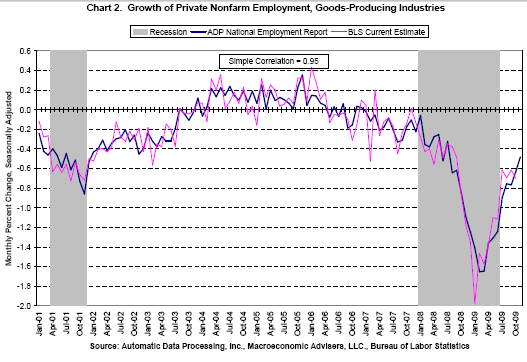We’ve seen pretty broad improvement in most labor market metrics in recent months. My tepid recovery scenario appears to be continuing. ISM employment is hitting new highs, jobless claims continue their steady march lower, federal withholding receipts are rising, and several independent reports are showing improvement.
This morning the Challenger layoff report showed another dip. Challenger reported 41K layoffs vs 67K last March. The ADP report also showed signs of private sector hiring. ADP is reporting 201K new jobs. While the ADP has tended to be fairly volatile it is generally pretty closely correlated to the government’s data over long periods of time:

Federal income tax withholding receipts are also pointing to another positive month for employment (via Business Insider):
Federal Withholding Tax Receipts
JP Morgan analysts are looking for 185K this month vs consensus of 200K. They see over 220K new private sector jobs with a drag coming from the government:
“We forecast that total employment increased 185,000 in March, with the private sector adding 200,000 jobs during the month. Private sector hiring picked up in the second half of 2010 and the declines in jobless claims and other fairly upbeat employment indicators point to further improvement in the labor market. Nevertheless, we expect a bit of a slowdown from the pace of private sector hiring from February (+222,000), which appears to have been boosted by the return to more seasonal weather during the month after severe winter storms the prior month.
Manufacturing hiring has been pretty strong recently, which has corresponded with very high readings for the ISM manufacturing survey as well as regional manufacturing indicators (the IP manufacturing data have been solid, but not nearly as boomy). The regional surveys that are available for March show a similarly strong level of employment during the month to that seen in February, and we forecast an increase of 30,000 manufacturing payrolls. Construction employment jumped 33,000 in February, ending a run of five straight monthly reductions in employment. The increase in employment from February likely involved some payback from the weather-related reduction in employment the prior month, rather than an indication of an acceleration in construction activity.
We should see increased employment in most of the other private service sectors in March. Even with the
bad weather in January, most of the major industry groupings have reported job gains in recent months; as the recovery progresses and the labor market heals, we expect these gains to become more consistent and stronger.We forecast that government payrolls declined by 15,000 in March. State and local governments have been shedding jobs lately as concerns about government spending have mounted, and we expect this trend to continue for some time. The unemployment rate dropped 0.9%-pt between November and February, and we expect it to hold at 8.9% in March after this sizable decline. Going forward, there should be some further gradual improvement in the unemployment rate, but the pace of decline from recent months seems unsustainable.”
All in all, it should be a decent report. The market is going to be hoping for a Goldilocks report – not too hot, not too cold. And if anything, too cold. A hot report (225K+?) will likely start chatter about an end to the Fed’s accommodative stance and could put downward pressure on the market. If JP Morgan is right the market should brush off this report just as it has the last few. All in all, it’s hard to make a good story look bad. The job’s recovery is the missing link in the recovery. An upside surprise really wouldn’t be an unwelcome development….
Mr. Roche is the Founder and Chief Investment Officer of Discipline Funds.Discipline Funds is a low fee financial advisory firm with a focus on helping people be more disciplined with their finances.
He is also the author of Pragmatic Capitalism: What Every Investor Needs to Understand About Money and Finance, Understanding the Modern Monetary System and Understanding Modern Portfolio Construction.

Comments are closed.